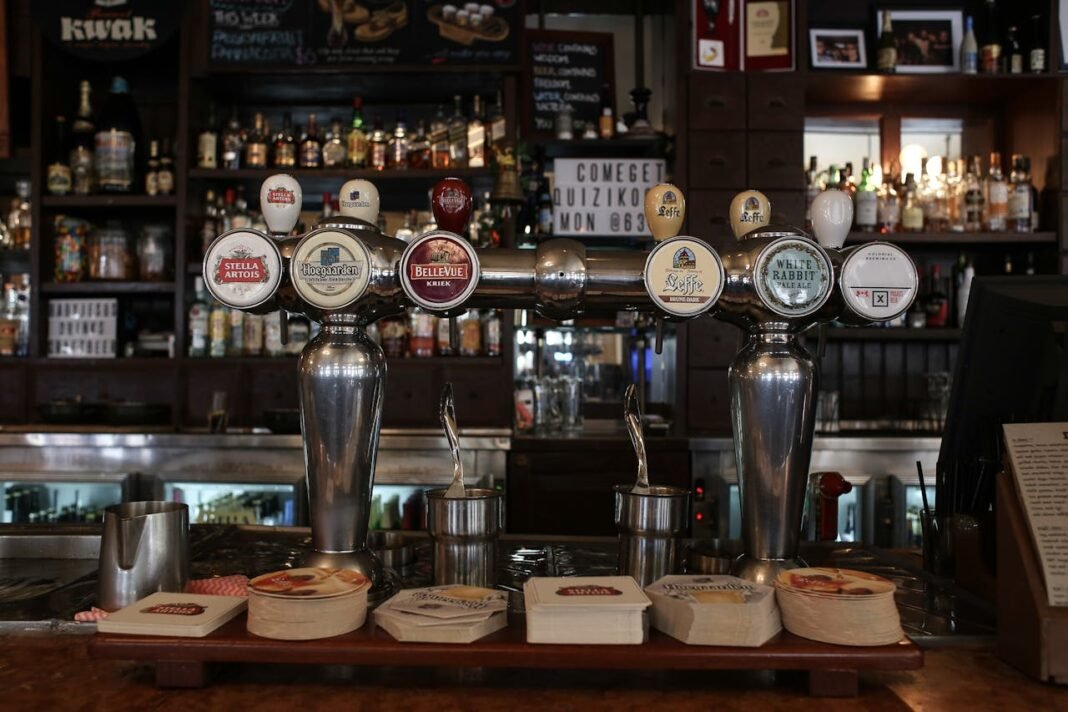Difference Between a Bar and a Pub
If you like going out for a drink, you’ve probably used the words “bar” and “pub” without thinking much about it. They might seem like the same thing, but have you asked yourself: what’s the difference between a bar and a pub?
While bars and pubs can both be great places to hang out, have a drink, and enjoy time with friends, there are some key differences between them. Some are about history, some are about culture, and some are about how the places feel. In this post, we’ll explore the difference between a bar and a pub—where the terms come from, how they’re used today, and whether those differences really matter in the end.
Let’s Have a Look at the History

What is a Pub?
“Pub” is short for “public house.” This term has been used in the UK for hundreds of years. Pubs were originally places where travelers could rest, get a warm meal, and have a drink. Over time, they became social spots in villages and towns, where locals would gather, talk, and share news.
Pubs are deeply rooted in British and Irish culture. Some pubs in England are over 1,000 years old! They were often the center of community life. People didn’t just go to pubs to drink—they went to meet their neighbors, relax after work, or even hold community meetings.
What is a Bar?

The word “bar” has a different story. It comes from the counter or rail where drinks are served—that’s the “bar.” Over time, the word began to describe the whole place. Bars became popular in the United States and other countries in the 19th and 20th centuries.
Bars were often seen more as places to drink alcohol than as social centers. They might be louder, darker, and more focused on partying or nightlife. So, one major difference between a bar and a pub is historical: pubs started as cozy community centers, while bars began as places mainly for drinking.
The Look and Feel
Atmosphere in a Pub
Pubs often feel warm and homey. You might see wooden tables, soft lighting, old paintings, or even a fireplace. The music is usually not too loud, so people can talk easily. There may be a dog sleeping in the corner or a group of old friends chatting over a pint of beer.
The furniture may look a little worn, but that adds to the charm. Many pubs serve hearty food like pies, roasts, or fish and chips. They often have real ale or local beers on tap. In short, pubs feel comfortable and familiar. They’re a place to unwind, not just to drink.
Atmosphere in a Bar
Bars are usually more modern, with louder music, bright lights, and sleek furniture. Some bars are designed for dancing or watching sports, with big screens and high-energy vibes. Others might have a theme, like a cocktail bar or a rooftop bar.
Bars often serve mixed drinks, shots, and cocktails. You might not find much food at some bars—maybe just snacks or appetizers. So, another difference between a bar and a pub is the vibe. Pubs feel relaxed and cozy; bars feel exciting and upbeat.
What’s on the Menu?
Drinks in a Pub
Pubs usually focus on beer—especially draft beer. You’ll often find a wide selection of ales, lagers, stouts, and ciders. In the UK, pubs may serve “real ale,” which is beer brewed in traditional ways and served from a cask without added gas.
While you can still get spirits or wine in a pub, beer is the main focus.
Drinks in a Bar
Bars often have a full menu of alcoholic drinks. You’ll find cocktails, shots, craft beers, and all kinds of mixed drinks. Many bars also have skilled bartenders who can make fancy or trendy drinks.
Bars are more about the experience of drinking itself, rather than just relaxing with a pint. So, yet another difference between a bar and a pub is the kind of drinks they serve and how they serve them.
Food Options
Pubs usually serve full meals. In fact, in many places, pubs are known for their food just as much as their drinks. It’s not unusual to have a Sunday roast, a steak pie, or bangers and mash at a pub.
Bars, on the other hand, might serve snacks or small plates. Some bars don’t serve food at all. Of course, there are “gastro bars” or “bar-restaurants” now, so it can vary, but the traditional difference still holds in many cases.
Who Goes There?
The kind of crowd you see is also part of the difference between a bar and a pub.
Pubs often attract regulars—people who go there often and know the staff and each other. There’s often a friendly, familiar feeling. You might see older people, families, and groups of friends.
Bars often draw a younger crowd, especially in the evenings and on weekends. They’re more popular with people looking to party, dance, or meet new people. It can feel more fast-paced and less personal.
Entertainment and Activities
At a Pub
Pubs often have traditional pub games like darts or pool. Many also have quiz nights (also called pub trivia), live music, or karaoke. But the main form of entertainment is usually conversation and socializing.
You might also find sports on TV, especially football (soccer) in the UK. But it’s usually not the main focus.
At a Bar
Bars may have DJs, live bands, or dance floors. Some host themed nights, like ladies’ night or singles’ night. Others focus on sports and have lots of big screens and loud cheers when a team scores.
The entertainment is usually louder and more intense than in a pub. So when it comes to having fun, the difference between a bar and a pub is in how you want to enjoy your time—quiet conversation or high-energy action.
Rules and Opening Hours
Another practical difference between a bar and a pub is how they’re run. Pubs, especially in the UK, are often limited by local laws. They might have set opening and closing times, and they may need a license to serve food or drinks. They might also have to follow rules about noise or smoking.
Bars, especially in the U.S. or cities with a big nightlife scene, can sometimes stay open later. They might not serve food, but they focus more on the drinking experience. In general, pubs open earlier in the day and are family-friendly, while bars often open later and focus on adults-only nighttime fun.
So… Does It Really Matter?
Now that we’ve looked at all the ways pubs and bars are different, let’s ask the big question: does it actually matter?
The truth is, it depends on what you’re looking for. If you want a quiet place to chat with friends, eat a good meal, and sip a pint, a pub might be perfect for you. If you’re in the mood for music, cocktails, and a night out dancing, then a bar is probably your scene.
Still, the difference between a bar and a pub can help you choose the right place for the right mood. It’s not just about the drinks—it’s about the whole experience.
That said, the lines are starting to blur. In many cities, you’ll find pubs that feel more like bars, and bars that offer full meals like pubs. The modern world mixes things up. Some places even call themselves “gastropubs” or “bar-pubs” to try and be both.
But knowing the difference between a bar and a pub can still be helpful, especially if you’re traveling or trying something new. It can help you set your expectations and have the best time possible.
Final Thoughts
So, what’s the final word on the difference between a bar and a pub?
- Pubs are cozy, friendly, and often feel like a second home. They focus on community, conversation, and comfort.
- Bars are lively, modern, and designed for fun nights out. They focus on energy, music, and a wide range of drinks.
| Feature | Pub | Bar |
|---|
| Origin | UK, centuries old | US, more recent |
| Vibe | Cozy, calm, local | Lively, energetic, modern |
| Drinks | Beer-focused | Cocktail/mixed drink-focused |
| Food | Full meals | Snacks/small plates (if any) |
| Crowd | Regulars, mixed ages | Younger, party vibe |
| Entertainment | Trivia, darts, light music | DJs, sports, dancing |
In the end, both have their charm. Whether you choose a bar or a pub, what matters most is who you’re with and how you feel while you’re there.
So next time someone asks you the difference between a bar and a pub, you’ll have a clear, simple answer—and maybe even a few fun stories to share over a drink.
All the images in this article are from Pixabay (not copyrighted and free for commercial use).






